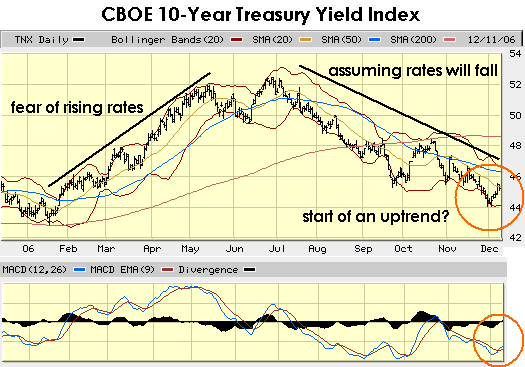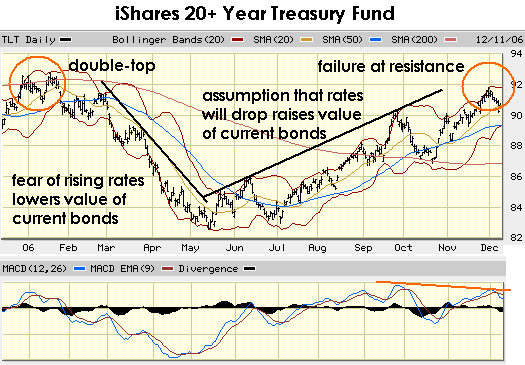

|
| weblog/wEssays archives | home | |
|
What If Rates Don't Drop? (December 12, 2006) The financial media and raftloads of sundry pundits assume the Fed will lower interest rates shortly. But rather than pontificate, let's look at some charts. What we have here are two charts which reflect the market's assessment of where rates are heading. The first depicts the yield on Treasury bonds, the second the value of long-term Treasuries. The two work like a see-saw. When rates are rising, the yield rises while the value of existing long-term bonds drop. When rates are falling, the value of current bonds rise (because their higher yield makes them more valuable than lower-yield new bonds) and yields correspondingly fall. 

It's impossible not to notice that both charts seem to have ended their move, and are starting to reverse direction. What this means is the market seems not to believe the pundits and all their blather about how rates have to drop because the economy is slowing. Au contraire, mon ami--these charts reveal that the market is now beginning to anticipate a possible rise in rates. Does this make sense? Perhaps not in the standard scenario, but this isn't a standard scenario. At no other time, in this nation or any other, has the financing of gargantuan debt remained so heavily dependent on the willingness of foreign investors. The only historical analog I know of is Imperial Spain, which in its declining decades relied heavily on Dutch lenders to fund its deficits. The collateral, of course, was the gold and silver pouring in from Spain's New World possessions. Does the U.S. has equivalent collateral for the trillions in dollars we've borrowed from the Chinese, Japanese, Saudis, et. al.? No. That should make you wonder if our lenders are entirely happy holding trillions in unsecured debts. Yes, the Treasury can always print off another trainload of dollars to pay the foreign investors' interest, but isn't this the classic recipe for inflation? And what happens then? Rates rise--which is precisely what these charts are indicating. The stock market won't appreciate the demolition of the fantasy that rates will soon be falling, nor will the bond market. But let's not stop there--let's look at some other portents of doom: Correspondent Jed H. noticed a sudden spike up in Mr. Softy (Microsoft- MSFT) in the last few minutes of trading on Friday: As you have Posted stuff RE: Manipulated Stocks / MKT, just have a close look at yesterday's "Moves" in MSFT ! It traded "Flat", at about $ 28.90 for ~ 5.5 hr, & then started UP in last Hour, followed by a "SPIKE" up ~ 2% ( ~ $0.50 to $ 29.40 ) in last ~ 15 min of trading -- TWICE Avg Volume to ~ 108 MILN shares, vs 59 MILN ; I found it "only takes" ~ $1.50 BILN & ~ 50 MILN shares to move MSFT ! What is your take ??! ( NOT, orderly stock pricing ?)Large traders don't build positions in the last few minutes of trading; that's called "painting the tape," when the big traders push a stock in the direction they want the "greater fools" to believe is the "market direction." Next up, astute reader Bruce H. sent in this sobering fact: Was reading Doug Noland's recap of Q3 flow of funds when the following caught my eye - it's from Daniel Hauck at Bloomberg:As noted here earlier in the month: when insiders are dumping like crazy, the top is rather glaringly in. We've also noted here the "megaphone top" formation and the big divergence between MACD and RSI (dropping) and the indices' price levels (rising). For younger readers, we might also mention that 1987 was famous for a 22% drop in the Dow Jones Industrials--not for the year, or in a month, or even in a week--but in a single day. If you really want to believe the happy story about how great everything will be because the Fed is poised to drop interest rates, be my guest. But are there any charts or other evidence which supports that thesis? For more on this subject and a wide array of other topics, please visit my weblog. copyright © 2006 Charles Hugh Smith. All rights reserved in all media. I would be honored if you linked this wEssay to your site, or printed a copy for your own use. |
||
| weblog/wEssays | home |